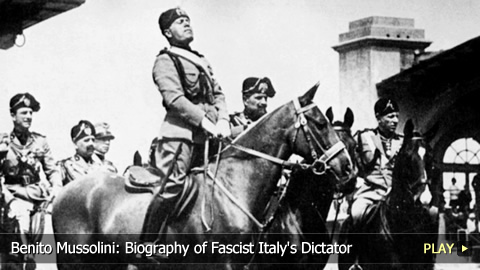Benito Mussolini: Biography of Fascist Italy's Dictator

- Early Life
- Burgeoning Socialist
- Back in Italy
- Ejection from the Socialist Party
- Return to the Military
- Italian Combat Squad and the "Biennio Rosso"
- The National Fascist Party
- Benito Mussolini: Italian Prime Minister
- Italy Becomes a One-Party State
- Widespread Support
- The Lateran Pact
- The New Roman Empire
- Mussolini and Hitler
- World War II
- Italy Joins the War
- Dismissal and Arrest
- Germany Invades Italy
- Mussolini and the Italian Socialist Republic
- Capture and Murder
- Legacy
Early Life
Benito Amilcare Andrea Mussolini was born July 29th, 1883 in Predappio, Italy. Due to his father’s political inclinations, he was named after prominent socialist leaders.
Burgeoning Socialist
Mussolini was a disruptive but intelligent student. He developed beliefs similar to his father’s, and joined the Socialist Party in 1900. After graduating, he worked briefly as a teacher, before moving to Switzerland in 1902 to evade military service.
Back in Italy
In 1904, Mussolini was deported to Italy and served two years in the Army. He was soon considered one of the country’s foremost socialists, and after becoming editor of the Socialist Party newspaper Avanti!, he significantly improved readership.
Ejection from the Socialist Party
When World War I began in 1914, the Socialist Party disapproved of Italian intervention. Mussolini eventually supported the war, and this got him ejected from the party. He then aligned himself with revolutionary nationalist beliefs and produced the pro-war newspaper Il Popolo d’Italia.
Return to the Military
In 1915, Mussolini rejoined the Army and served in the war before an injury sent him back to his newspaper job.
Italian Combat Squad and the “Biennio Rosso”
By 1919, he created the Italian Combat Squad as an alternative to socialism. This coincided with a period of Italian social discord known as the “biennio rosso” or “two red years,” when his paramilitary fascist Blackshirts publicly sparred with socialists and other groups.
The National Fascist Party
In 1921, the Combat Squad became the National Fascist Party, and Mussolini won a seat in the Italian Chamber of Deputies.
Benito Mussolini: Italian Prime Minister
His Party was soon ready for power. In October 1922, the March on Rome resulted in the Fascist Party seizing power. On October 31st, 1922, Benito Mussolini became the fortieth Prime Minister of Italy, and the youngest to that point.
Italy Becomes a One-Party State
Mussolini spent the next years disassembling the Italian democratic system, using propaganda to portray himself as the only man capable of unifying the country, and transforming Italy into a one-party state. In 1925, he made himself dictator and took the title of “Il Duce” or “the leader.”
Widespread Support
The Fascists were accused of using violent force to crush political foes. However, despite some assassination attempts, Mussolini was initially widely supported due to his efforts fighting unemployment and financial decline.
The Lateran Pact
One of Mussolini’s most significant achievements was the Lateran Pact of 1929. This treaty settled the longstanding dispute between Italy and the Roman Catholic Church and created the independent state of Vatican City.
The New Roman Empire
Mussolini then began colonizing African countries to create a New Roman Empire. For example, 1935’s Ethiopian War resulted in that country’s seizure by the Italian Empire.
Mussolini and Hitler
In 1936, Mussolini sent military aid to Spanish dictator Francisco Franco in the Spanish Civil War. This pushed Mussolini closer to Nazi Germany’s dictator, Adolf Hitler, though their early relationship was unstable. To strengthen ties, Mussolini adopted the anti-Semitic Manifesto of Race in 1938, despite disagreeing with its premise.
World War II
In 1939, the Pact of Steel solidified the Rome-Berlin Axis of 1936. Despite this, Italy initially remained uninvolved in World War II following Germany’s invasion of Poland.
Italy Joins the War
By June 1940, Mussolini thought the war was almost over, so he entered Italy in the conflict as an Axis Power by declaring war on Britain and France.
Dismissal and Arrest
Losses in Greece and North Africa soon showed Italy’s military shortcomings. From 1942, Mussolini steadily lost support. Following the Allied invasion of Sicily in July 1943, he was ousted from power by the Italian king, and subsequently arrested.
Germany Invades Italy
In his absence, the Fascist Party was disbanded, and a truce was signed with the Allies. Germany then invaded Italy in September 1943.
Mussolini and the Italian Socialist Republic
Meanwhile, German forces freed Mussolini from prison. He wished to retire from politics; however, he ended up Hitler’s puppet as head of a new fascist regime called the Italian Socialist Republic.
Capture and Murder
The Allied presence then spread northward through Italy. On April 27th, 1945, as Mussolini attempted to escape to Switzerland, he was captured by Italian partisans and executed by firing squad the next day. His body was then hung in a Milan town square to dissuade other Fascists from carrying on the cause.
Legacy
Due to his vanity, womanizing and egotism, Benito Mussolini shaped Italian and world history, and proved himself as one of the twentieth century’s most controversial dictators.


 1
1
 0
0
 report
report